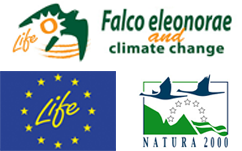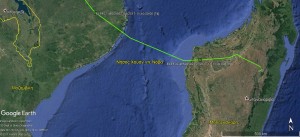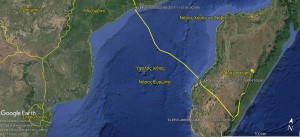For the second consecutive winter the two female Eleonora’s falcons with satellite transmitters fitted on them arrived at Madagascar! The two birds were equipped with microscopic devices in autumn of 2016 under the LIFE ElClimA project and since then they have been monitored by the project ornithologists for the identification of the important areas for the survival of the species, outside the breeding season.
Each of the female Eleonora’s falcons has “traveled” more than 25,000 kilometers in just 15 months! It is undoubtedly something particularly impressive if we compare this to the human measure, but in fact it is nothing else but an “annual routine” for every Eleonora’s falcon of the world.
The two birds arrived at Madagascar only with a few days difference, after nearly three weeks of crossing almost all of Africa.
Plagara arrived first on the November 8, having chosen to cross the Mozambique Channel more southern than usual. The channel at that point has a width of 800 kilometers. Plagara crossed it after 24 hours of continuous flight. Instead of stopping to rest as soon as she reached the coast of Madagascar, she flied another 450 kilometers in even higher speed (8 hours) to finally park on the eastern side of the island! Thus, a total of 1250 kilometers in 32 hours.
Thimonia reached the Mozambique coast in the early hours of November 10. Without delay, she began crossing the sea area and found herself in Madagascar at midnight of the following day. She had traveled a distance of 700 kilometers in 24 hours, following a more “traditional rout” for Greek Eleonora’s falcons, which leads to the northeastern part of the island.
Simultaneously with these two cases and in contrast to the dominant habit of the species, an adult dark-colored Eleonora’s falcon was observed at Antikythera Island on November 25 by the field group of Hellenic Ornithological Society (being on the island for the implementation of Action C3 regarding the creation of “oases of supply” for migratory birds).
Until today (early December), the two falcons continue to send their spots every day, contributing even more to improving our knowledge about the species.
Thimonia entrances Madagascar Plagara entrances Madagascar

 Ελληνικά
Ελληνικά English
English
